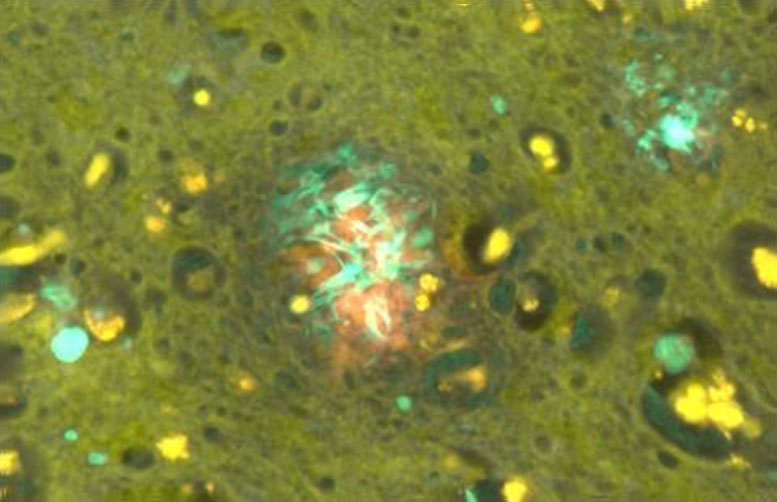Alzheimer’s Disease Linked to Aluminum Exposure

Amyloid-beta
(green fluorescence) and aluminum (orange fluorescence) in Senile Plaque from brain tissue of a familial Alzheimer’s disease donor.
Credit: Neurobiology, University of Texas at San Antonio
A growing body of research is linking human exposure to aluminum with Alzheimer’s disease (AD).
Researchers found significant amounts of aluminum content in brain tissue from donors with familial AD. The study also found a high degree of co-location with the amyloid-beta protein, which leads to early onset of the disease.
“This is the 2nd study confirming significantly high brain accumulation in familial Alzheimer’s disease, but it is the 1st to demonstrate an unequivocal association between the location of aluminum and amyloid-beta in the disease.
It shows that aluminum and amyloid-beta are intimately woven in the neuropathology,”.
“New research confirms that within the normal lifespan of humans, there would not be any AD if there were no aluminum in the brain tissue.
No aluminum, no AD.” —
Dr. Christopher Exley
In an earlier study, brain tissue from donors in the United Kingdom diagnosed with familial AD showed significant accumulations of aluminum.
To further understand this relationship, in the current study the researchers measured aluminum in the brain tissue of a cohort of Colombian donors with familial AD who shared a specific mutation. The mutation leads to elevated levels of amyloid-beta, early disease onset, and an aggressive disease etiology.
The levels were compared with a control set of brain tissues from donors with no diagnosis of neuropathological disease. They also used aluminum-specific fluorescence microscopy imaging to investigate the relationship between aluminum and amyloid-beta in familial AD.
The results were striking.
The aluminum content of the brain tissue from donors with the genetic mutation was universally high, with 42% of tissues having a level considered pathologically significant, and the levels were significantly higher than those in the control set.
The imaging studies identified aluminum deposits in all brain tissues studied. They were predominantly co-located with amyloid-beta in senile plaques and occasionally in the brain vasculature. Aluminum was also found separately from amyloid-beta in intracellular compartments including glia and neuronal axons.
The results strongly suggest that genetic predispositions known to increase amyloid-beta in brain tissue also predispose individuals to accumulate and retain aluminum in brain tissue.
“Compelling localization of aluminum with a central player in AD, amyloid-beta, strengthens the link of aluminum to the pathogenesis of AD,”.
“One could envisage increased amyloid-beta in brain tissue as a response to high levels of aluminum content, or that aluminum fosters the accumulation of amyloid-beta,” said Dr. Exley.
“Either way, the new research confirms that within the normal lifespan of humans, there would not be any AD if there were no aluminum in the brain tissue. No aluminum, no AD.”
Reference:
- https://scitechdaily.com/alzheimers-disease-linked-to-exposure-to-aluminum/
- “Aluminum and Amyloid-β in Familial Alzheimer’s Disease” by Matthew Mold, Caroline Linhart, Johana Gómez-Ramírez, Andrés Villegas-Lanau and Christopher Exley, 13 January 2020, Journal of Alzheimer’s Disease.
Comments
Post a Comment